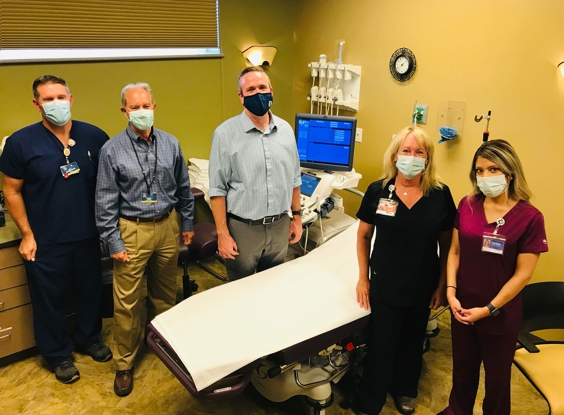General Guidelines
- Pelvic floor muscles. During pregnancy, your pelvic floor muscles get stretched. Those muscles get stretched more following a vaginal birth. All women, but especially postpartum women need to exercise the pelvic floor muscles correctly. The goal is to protect the pelvic floor muscles while you are vulnerable post-partum and to help ensure restoration of healthy tissue.
- Exercise is best when managed by your physical therapist to instruct in proper performance, to keep joints and pelvic floor safe, keep track of your blood pressure and to make sure that you are safe during the first part of the postpartum period.
-
Log roll from lying down to getting up, or from being up to lying down.
- If you perform a sit up (vs. a log roll), you can delay healing of your abdominal tissue.
- Do not perform a sit up of any kind until your pelvic floor and abdominal muscles are strong enough. The downward pressure during a sit up can weaken your pelvic floor and you could develop a vaginal wall laxity, the precursor to organ prolapse. Pelvic floor strength and abdominal healing can be determined by a pelvic floor physical therapist.
- The joint laxity that you experienced during pregnancy takes time to reduce, making you more at risk for instability injuries. It is important to increase strength, exercise safely, and move correctly in order to protect your body during this time. You will need to slowly work up to exercise loads similar to those you did prior to your pregnancy.
- Lifting mechanics. Lifting and moving correctly around your house and with your baby is the best way to gain strength and protect your pelvic floor. You can gain strong abdominals, thighs, buttocks and pelvic floor muscles just by moving correctly.
- Side lying to breast feed is a great option: Try the side laying approach with a pillow between your knees, a pillow behind your back for support, and your bottom in line with your head. The less you work the better. Cuddle you baby on his or her side next to you, tummy to tummy. The baby’s nose should be level with your nipple. Use your hand to lift and guide your breast so that baby can latch on. Consider talking with your lactation consultation as this is an ad-vanced position and it changes your latch.
- Avoid constipation and bearing down during bowel movements.
- Bowel massage. If your bowels are hard, slow, or if you are bloated with gas, performing a gentle belly massage may help. Perform for 3-5 minutes, 2-3 x/day. Using fingers make small circular motions, starting at right hip, move up to right ribs, across belly, down to left hip.
First Two Weeks
- Consider relaxing with your baby for about 2 weeks! This helps decrease your chance of developing prolapse and helps you heal. Be sure and walk around your house and do ankle pumps to avoid developing a DVT. Avoid long walks, prolonged standing, running, sit-ups.
- Perform the transverse abdominus/lower belly pull exercise and the pelvic floor activation exercises as instructed by the physical therapist. This is best started immediately. For example, 10 short and 10 long holds every time you feed your baby.
- Consider wearing an abdominal binder for 6 weeks post-partum. This helps assist your abdominal wall to return to normal length.
Six Weeks Postpartum
- You should be having a follow up appointment with your physician. Discuss any problems you may be having. See list below for what is abnormal.
- At this time you are usually cleared by your doctor to increase your activity level and participate in sex if you are ready.
- Come see your pelvic floor physical therapist. They have specialized training to assess strength, mobility, motor control and laxity around your pelvis. Early care can prevent complications and minimize the effect of trauma that occurred to your pelvic floor during birth.
- Your pelvic floor therapist can coach you through safe return to exercise, pelvic floor strengthening, abdominal activities, posture, body mechanics, and address any pain or movement-based concerns.
Things that are “not normal” but can happen
If you experience any of these, please consider seeing a pelvic physical therapist sooner rather than later. It is easier to fix problems now!
- Pain after 6 weeks.
- Pain with intercourse, bowel movements, urination, sitting, walking, moving in bed, etc.
- Abdominal pain, hip pain, low back pain, pubic pain, pelvic pain, tailbone pain, thoracic pain, shoulder pain, neck pain.
- Anything falling out of your vagina or a feeling of heaviness in your vagina.
- Burning or itching around your vaginal opening, rectal opening, or in your pelvis.
- Sensitive scars.
- Urine leaking – even a little bit!
- Fecal leaking/Constipation
- A separation in your rectus abdominus muscles, or a pooch out when you move.
- Something just doesn’t “feel right”
- Inability or difficulty achieving orgasm.
Episiotomy/Tear Recovery
If you had an episiotomy you are at increased risk for pelvic floor dysfunction and need to monitor the abnormal signs listed above more closely. You are at an increased risk for prolapse, incontinence and pelvic pain. We recommend consulting with a pelvic floor physical thera-pist if you had an episiotomy or significant perineal tearing.
-

-
Birth Experience Family Birth Center
My birth experience was incredible.
-Submitted by Anonymous -
Allowing Mom and Baby to Bond Family Birth Center
I appreciate you allowing the mom and baby bond just after birth. It is so important because we don't get that time back.
-Submitted by Anonymous
/




